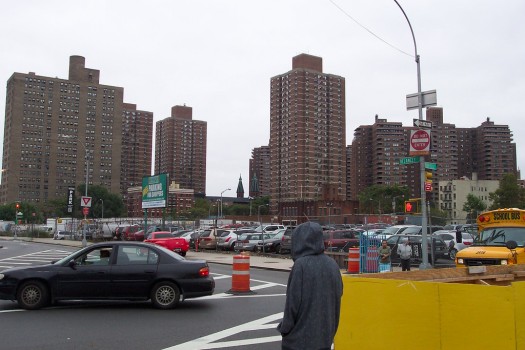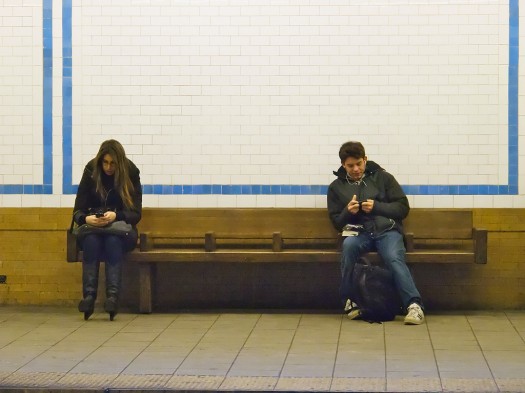
We are celebrating 15 years — and counting — of stories that are deeply researched and deeply felt, that build a historical record of what the city has been.
We are celebrating 15 years — and counting — of stories that are deeply researched and deeply felt, that build a historical record of what the city has been.

SPURA site | from Flickr user L’Hibou.
AFTER 40 YEARS SPURA MIGHT BE GETTING DEVELOPED
The 1960s saw huge swaths of New York City cleared in the name of Urban Renewal. The legacy of population displacement and towers-in-the-park housing is still apparent along the shorelines of the Lower East Side and the East Village, but some lots were cleared and never built out. The Seward Park Urban Renewal Area (SPURA), a five lot, seven acre, city-owned plot on Delancey Street, has been left barren for the past 45 years, but it’s on its way to becoming one of Manhattan’s largest redevelopment projects on city-owned land. On Tuesday night, Community Board 3 (CB3) approved the 1.65 million square foot mixed use development (40% commerical, 60% residential), after negotiations about how much of the housing would be affordable and for how long. CB3 had previously been holding out for 100% of the housing to be affordable, but compromised on 50% as long as the affordability was maintained in perpetuity. While the vote Tuesday night is a good sign for the future of the site, the development process is just beginning. According to City Councilwoman Margaret Chin, “the City agreed to create a task force to ensure that this community remains involved as this process moves forward,” in order to maintain continuing neighborhood involvement and face concerns ranging from the availability of parking spaces to the invasion of big box retail. Check out the coverage at Crain’s New York and Streetsblog.
PRESUMPTIVE MAYORAL CANDIDATES TAKE ON TRANSIT
New York City’s public transportation system is one of its defining features, but the MTA has a long history of working at a glacial timescale with constant construction delays and cost underestimation. Reclaim, the magazine of the advocacy group Transportation Alternatives, has been asking the city’s presumptive mayoral candidates four questions about the transportation system:
While some of the questions can be a little bit leading, the importance of the transportation network to the voting population is clearly on the minds of the candidates. Manhattan Borough President Scott Stringer seems to be the most critical of how the MTA is currently spending its money. City Council Speaker Christine Quinn is pushing an expansion of the network to include more ferry service. All the presumptive candidates are concerned about bicyclists’ safety, and all agree on the importance and feasibility of expanding the Select Bus and Express Bus services. Read responses of Tom Allon, Public Advocate Bill de Blasio and Manhattan Borough President Scott Stringer here and the responses of Comptroller John Liu and Speaker Christine Quinn here.
METHANE HARVESTING AT FRESHKILLS
As the transformation of Freshkills from one of the world’s largest landfills to one of the city’s largest parks accelerates, the decomposition of the generations of accumulated trash continues to produce methane gas. Now, the Department of Sanitation is beginning to harvest that gas for energy production, enough energy to power 22,000 homes. By selling the methane to the National Grid, the City is earning about $12 million annually. Read more at the Freshkills Park Blog.

Are smart phones making us ruder? | from Flickr user Ed Yourdon.
ARE SMART PHONES MAKING US RUDER?
The Atlantic keeps wringing its hands at the effects of technology on society with “Is Google Making Us Stupid?“ and, more recently, “Is Facebook Making Us Lonely?” and now Atlantic Cities is extending that question to the built environment with “How Smart Phones Are Turning Our Public Places Into Private Ones.” We’ve all bumped into someone on the street that was staring at his smart phone, seemingly following his own progress as a blinking blue dot on a digital map rather than watching where he’s going in the physical world. The article cites the sociological research of Tali Hatuka of the Laboratory for Contemporary Urban Design at Tel Aviv University, specifically questioning the influence of smart phones on basic human interactions that form the basis of common courtesy in highly populated cities (like asking for directions) and comparing the survey responses of smart phone users with those of users of traditional cell phones (dumb phones?). As it turns out, smart phone users are not only less likely to interact courteously with strangers, but also remember much less about their physical surroundings.
EVENTS and TO DOs
SCREENING: TRUCK FARM
Last year, filmmaker Ian Cheney spoke with us about light pollution and the importance of reconnecting our cities and ourselves to the night sky. Next week, see what Cheney has to say about reconnecting our cities to agricultural production at a screening of his latest documentary Truck Farm at Central Park’s Arsenal Gallery. Truck Farm follows the filmmaker as he plants a vegetable garden in the back of his grandfather’s old pick-up truck, which he then uses to shuttle between other urban agriculture sites around New York. This “whimsical call-to-farms” will be shown on Tuesday, May 29 at 6pm with a reception following. To RSVP, click here.
GRAPHIC DESIGN – NOW IN PRODUCTION
While the Carnegie Mansion, the main digs of the Cooper-Hewitt National Design Museum, is under construction, the museum has been dispersing exhibitions throughout the city. This weekend they’re opening Graphic Design – Now in Production on Governors Island. Graphic design practices have been expanding with the opportunities afforded by new technologies and new interests in design driven media. The exhibition runs May 26 through September 3, weekends and holiday Mondays 10am-6pm, Building 110, Governors Island, New York. More information is available here, and check out a review at Design Observer.
The Roundup keeps you up to date with topics we’ve featured and other things we think are worth knowing about.
The views expressed here are those of the authors only and do not reflect the position of The Architectural League of New York.